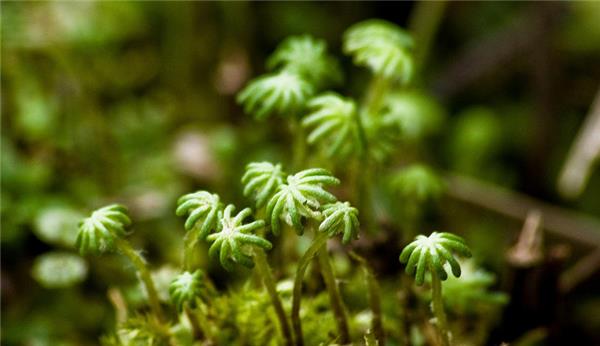Introduction and culture method of land money, an evaluator of atmospheric quality
Radix Rehmanniae is very sensitive to air pollution, so it is often used as an indicator of air quality. In areas with serious air pollution, land money is almost extinct, forming the so-called "lichen desert". Let's take a look at the knowledge of land money.

First, the introduction of land money
Diqian is a spore plant of the genus Artemisia, which is leafy, flat, creeping and green on the back, with a hexagonal air chamber with a stomata in the center, a stomatal chimney-shaped, and most upright nutrient filaments in the air chamber. There are purple scales and false roots on the ventral side. Dioecious, male receptacle disc-shaped, undulate-lobed, with many pores above, spermatogenic apparatus in the pore cavity, and short receptacle; female receptacle digitally or flakily parted, lower cervicular egg organ, stipe longer; oocytes develop into sporophyte after fertilization. The sporophyte consists of three parts: capsule, capsule stalk and basal foot.

Second, the morphological characteristics of land money.
The plant is leafy, flat, creeping, green on the back, with a hexagonal air chamber with a stomata in the center, a stomatal chimney-shaped, and most upright nutrient filaments in the air chamber. There are purple scales and false roots on the ventral side. Dioecious, male receptacle disc-shaped, undulate-lobed, with many pores above, spermatogenic apparatus in the pore cavity, and short receptacle; female receptacle digitally or flakily parted, lower cervicular egg organ, stipe longer; oocytes develop into sporophyte after fertilization. The sporophyte consists of three parts: capsule, capsule stalk and basal foot.
Radix Rehmanniae is one of the most widely distributed species in the bryophyte world. There is no real root, its false root has no function of absorbing water and inorganic salt, but only plays a fixed role; the stem is weak and has no dredging tissue; the leaves are green, small and thin, and can absorb water and inorganic salt in addition to photosynthesis. The capsule is spherical and contains spores and elastic filaments. after maturity, the top is irregularly cracked, and the spores are dispersed by the flexion and extension movement of elastic filaments under different humidity. The spores germinated to produce protonema under suitable conditions. Vegetative reproduction often produces buds from the bud cup on the back of the Thallus. Most of them are born on a wet substrate rich in organic matter.

It is one of the liverworts named by Linnai in 1753 and is widely distributed all over the world. Thalli is characterized by flat, banded, multiple dichotomous branches, light green or dark green, about 1 cm wide, up to 10 cm long, slightly wavy at the edge and intertwined into sheets. There is a hexagonal air chamber on the back, and the stomatal orifice is smoke-like, which bears most upright nutrient filaments. The basic tissue of the Thallus is 12-20 layers thick; the ventral surface is covered with 6 rows of purple scales with heart-shaped attachments at the tip of the scales; the base of the pseudoroots dense scales. Dioecious. Male receptacle discoid, undulate-lobed into 7-8-merous. The female receptacle is flattened and parted into 6-10 finger valves. Asexual reproduction is multiplied by multicellular disc spores in the spores cup at the front of the Thallus.

3. Cultivation techniques of Radix Rehmanniae
Cultivation and planting
The tissue mass of the chopped Thallus can sprout and grow into a complete Thallus.
The Agar culture method is the same as the general tissue culture (without adding hormones and other exogenous substances) except that the nutrient solution of the medium is prepared with the complete culture medium used in general plant physiological cultivation. This French is omitted. The following focuses on the method of plantlet formation and plantlet culture in vitro in flowerpot soil.
(1) the flowerpot leaves 1 stroke 3 space, and the lower part is placed in the water plate to maintain the soil moisture.
(2) about 3 × 1.5mm Thallus fragments were scattered on the soil.
(3) cover the basin (glass sheet or plastic film). A week later, the apical part of the Thallus can grow from the edge of the fragment, with a growing point. A more complete Thallus grew after three weeks.
(4) the problems that should be paid attention to in the process of training:
The ① temperature is kept at about 15-20 ℃.
② keeps the soil moisture from clear water.
Too high temperature or humidity of ③ is easy to produce algae, in addition to pay attention to adjust the temperature and humidity, iron forceps can be used to remove algae, because too much algae may make the Thallus turn yellow.
The above is the knowledge of land money. I hope I can help you.
Related
- Wuhan Hospital Iron Tree Blooming Result Was Instantly Frightened by the Gardener Master
- Which variety of camellia is the most fragrant and best? Which one do you like best?
- What is the small blue coat, the breeding methods and matters needing attention of the succulent plant
- Dormancy time and maintenance management of succulent plants during dormancy
- Minas succulent how to raise, Minas succulent plant pictures
- What are the varieties of winter succulent plants
- How to raise succulent plants in twelve rolls? let's take a look at some experience of breeding twelve rolls.
- Attention should be paid to water control for succulent plants during dormant period (winter and summer)
- Watering experience of twelve rolls of succulent plants
- Techniques for fertilizing succulent plants. An article will let you know how to fertilize succulent plants.



